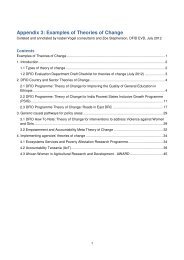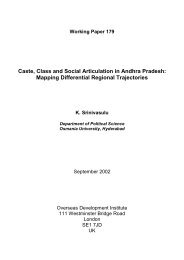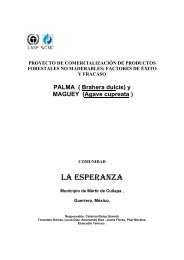Full Report - Research for Development - Department for ...
Full Report - Research for Development - Department for ...
Full Report - Research for Development - Department for ...
Create successful ePaper yourself
Turn your PDF publications into a flip-book with our unique Google optimized e-Paper software.
Search results<br />
access or satisfaction with services) were identified but excluded from our review.<br />
All included studies in the review were there<strong>for</strong>e assessed using quantitative<br />
checklist criteria (in the case of two economic evaluations, we were able to assess<br />
the quality of the empirical trial and separately use economic evaluation checklists).<br />
Almost a third (31 percent) of the included quantitative studies were identified as<br />
‘low quality’ by the team which meant both external and internal validity were<br />
scored as (-) low. Our causal chain analyses are restricted to medium- and highquality<br />
items only. We assessed item quality after completion of the searches, and<br />
to avoid exclusion of potentially valid items, quality was not part of the inclusion<br />
criteria. Of particular note was the lack of clarity or depth surrounding the ethical<br />
conduct of research that involved human subjects.<br />
Out of 114 studies, 21 were identified as high quality (++/++) and 14 medium quality<br />
(either ++/+ or +/++). For those high- or medium-quality studies which included<br />
specific interventions with clearly identified outcomes, we considered whether the<br />
study could be potentially included <strong>for</strong> meta-analysis. We obtained nine items of<br />
high quality and 8 of medium quality that met these criteria.<br />
Meta-analysis is particularly common in the analysis of studies which include clinical<br />
trials when the samples and results of individual studies are not conclusive enough to<br />
be able to generalise the overall results. It is also commonly used to remove bias<br />
from the conclusions as it combines the results of many trials and allows more<br />
transparency in the interpretation of the results. Despite the many advantages, it<br />
needs careful coding of the studies as well a careful evaluation of the quality of the<br />
papers. One of the key requirements above all <strong>for</strong> meta-analysis is a complete,<br />
unbiased collection of all the original studies of acceptable quality that examine the<br />
same therapeutic question (Crombie and Davies, 2009). This systematic review<br />
aimed <strong>for</strong> breadth rather than depth, given the lack of studies in the field.<br />
In Table 3.3, we show the distribution of the high-quality papers which were suitable<br />
<strong>for</strong> meta-analysis. The overall number of studies was nine, although in a few<br />
instances more than one outcome was included in the analysis.<br />
Table 3.3: Distribution of items coded as ‘high quality’ and suitable <strong>for</strong> metadata<br />
by outcome and focus<br />
Intervention<br />
outcome<br />
Clinical Non-clinical<br />
Maternal mortality Dumont et al. (2005)<br />
Neonatal mortality Darmstadt et<br />
al. (2008)<br />
Kaestel et al.<br />
(2005)<br />
Infant mortality Darmstadt et<br />
al. (2008)<br />
Kuhn et al.<br />
(2008)<br />
Martins et al.<br />
(2008)<br />
Dumont et al. (2006)<br />
Jakobsen et al. (2008)<br />
Mbori-Ngacha et al. (2001)<br />
What are the effects of different models of delivery <strong>for</strong> improving maternal and infant health<br />
outcomes <strong>for</strong> poor people in urban areas in low income and lower middle income countries? 27









